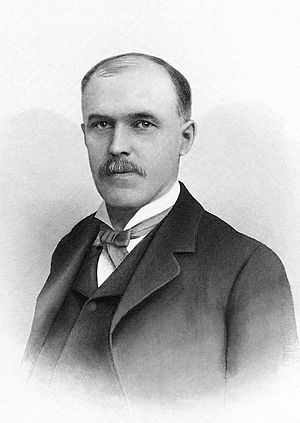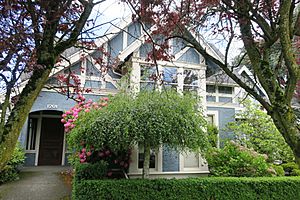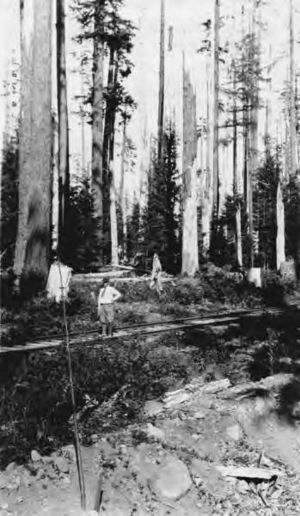J. J. Donovan facts for kids
Quick facts for kids
John Joseph Donovan
|
|
|---|---|
 |
|
| Born | September 8, 1858 |
| Died | January 9, 1937 (aged 78) |
| Monuments |
|
| Alma mater | Worcester Polytechnic Institute |
| Occupation |
|
| Years active | 1888 – c. 1935 |
| Organization |
|
| Known for | A Washington State pioneer and one of the key founders and developers of Bellingham, Washington who played a key role in the merger of Fairhaven and Whatcom, Washington. He was an active citizen, businessman, and political figure on city, county, and state levels. He established, developed, and directed lumber mills, coal mines, and small railroads. |
| Political party | Republican |
| Spouse(s) | Clara Isabel Nichols (married 1888 – 1936) |
| Children | 3 |
| Signature | |
John Joseph Donovan (born September 8, 1858 – died January 9, 1937) was a very important person in the early history of Washington State. He was a pioneer and helped create the city of Bellingham, Washington. Donovan was a key founder of Bellingham's City Council and even became the president of the state's Chamber of Commerce.
Throughout his life, Donovan was active in politics, business, and industry. He worked at the city, county, and state levels. You can still see places in Bellingham that honor him today. These include his house, which is now on the National Historic Register, and a bronze statue in Fairhaven.
One of Donovan's biggest achievements was helping to merge two towns, Fairhaven and Whatcom. These towns then became the city of Bellingham. He also helped set up the city's sewage system and built its first hospital. He was the vice president of the First National Bank of Bellingham. Donovan also designed the first ocean dock on the bay and created the first hydroelectric power plant in Whatcom County.
At the state level, he worked hard to get major highways built. As a businessman, Donovan started or managed many companies. These included railroads, lumber mills, and coal mines. He helped extend the Bellingham Bay & British Columbia Railroad line to Spokane. Later, he even connected Bellingham to Canada by railroad. He also helped the lumber and coal industries. He started the Blue Canyon Coal Mining Company and co-founded the Bloedel Donovan Lumber Mills. This company had many sawmills and shingle mills and employed 600 people.
In politics, Donovan was a strong member of the Republican Party. He also actively spoke out against the KKK in Washington State.
Contents
Early Life & Family History
John Donovan was born in Rumney, New Hampshire, on September 8, 1858. His parents were Patrick Donovan and Julia O'Sullivan. They both came to America from Ireland when they were young. They got married and settled in New Hampshire.
John's father, Patrick, worked as a foreman for the Boston, Concord & Montreal Railroad. Later, Patrick bought a farm in Plymouth, New Hampshire, and the family moved there. John was the oldest of seven children.
Education & First Jobs
John Donovan grew up on his family's farm in Plymouth. He went to public schools for his early education. In 1877, he graduated from the New Hampshire State Normal School. He also studied at the Tilton Academy.
His first job was teaching in public schools in New Hampshire and Massachusetts. However, he decided to become an engineer. He went to the Polytechnic School at Worcester, Massachusetts. He started there around 1879 or 1880 and graduated in 1882. John was chosen as the valedictorian (the top student) of his class. He was one of only two students offered a job at the Northern Pacific Railway.
Career Highlights
Engineering for Northern Pacific Railway (1882–1888)
In July 1882, Donovan moved west to work for the Northern Pacific Railway in Montana. He started as a rodman, helping to survey land for the railroad. Within a month, he was promoted to leveler. Six months later, he became an assistant engineer.
On September 8, 1883, John Donovan's 25th birthday, was a big day for the Northern Pacific Railroad. The main railroad lines from the east and west were finally connected near Gold Creek, Montana. Donovan traveled all night to be there for this important event. Many famous people attended, including President Ulysses S. Grant.
After this, Donovan worked on building many truss bridges. A few months later, he moved to Washington State. He worked on the Cascade division of the Northern Pacific. He also helped build the Cascade Tunnel. He worked as an engineer for tracks and bridges and as an engineer-in-charge. While surveying, he often crossed mountains with 20 feet of snow!
On June 1, 1887, a special switchback railroad system across the mountains was finished. After this big project, Donovan took his first vacation. He visited Alaska and his hometown in New England.
In September 1887, Donovan returned to work. He was put in charge of new railroad lines connecting to mining camps in Montana. After these were finished in spring 1888, Donovan left that job. Later that year, he got married and moved with his wife to Tacoma, Washington.
Building Bellingham Bay (1888 – c. 1935)
In 1888, Donovan left the Northern Pacific Railway. He accepted a job as chief engineer for several businesses around Bellingham Bay, Washington. He and his wife moved to Fairhaven. At that time, Fairhaven was a tiny village with only about 50 people. It had no stores or paved streets.
Donovan built his family home there and began to develop the town. He engineered projects for companies that built railroads and wharves (docks). He also helped plan the town's areas (zoned the territory) and started a coal mine. He worked on creating other important businesses the town needed.
By 1890, Fairhaven had grown into a city. Donovan served on its first and second city councils. He joined the Bellingham Bay Improvement Company in 1890. This company worked to develop industries like coal mining, railroad building, and lumbering. As chairman of the sewer committee, Donovan helped bring in an expert to plan the city's sewer system. He also designed and built the city's first ocean dock. He was the chief engineer for the Fairhaven Land Company, Skagit Coal & Transportation Company, and Fairhaven & Southern Railroad.
Railroad Business Contributions
In 1890, Donovan worked as chief engineer for the Fairhaven & Southern Railroad. This company planned a railroad line from Vancouver, British Columbia, to Portland, Oregon, and to Spokane, Washington. After 80 miles of track were built, the Great Northern Railway bought the line, and Donovan left.
In 1891, the Bellingham Bay & Eastern Railroad Company was formed. Donovan worked as an engineer there. He helped expand the line from Fairhaven to Whatcom and then to Wickersham. This connected it with the Northern Pacific Railway.
In 1898, Donovan became the general superintendent and chief engineer of the Bellingham Bay & British Columbia Railroad. He extended this line to Spokane. By 1903, under his leadership, the railroad had 40 miles of track working. Donovan worked hard to connect Bellingham with Canada by rail.
Lumbering & Mining Businesses
In 1891, Donovan started working as an engineer for land appraisers. He helped create the Blue Canyon Coal Mining Company. He built its bunkers (storage areas) and served as its vice president.
In 1898, Donovan partnered with Julius Bloedel and Peter Larson. They started the Lake Whatcom Logging Company. He served as vice president and later president of this company. In 1900, the partners founded the Larson Lumber Company and built a mill. On April 1, 1913, these two companies joined together to form Bloedel Donovan Lumber Mills. Donovan was the vice president and managed the logging part of the business.
By 1917, the new company had three sawmills and two shingle mills. They owned logging camps and timber lands. They also had their own rolling stock (train cars) and operated 30 miles of railroad. The company used the newest equipment and employed 600 men. They even provided health care for their employees. Later, Donovan gave some land to the city, which became Bloedel Donovan Park.
Other Important Activities in Bellingham
By 1903, Donovan was leading companies that successfully mined coal and other minerals. He also helped develop the first hydroelectric power plant in Whatcom County, located on the Nooksack River.
Donovan was an officer in several companies, including the Fairhaven Water Company and the Bellingham Bay Transportation Company. In 1900, Donovan moved his family to Whatcom, Washington. He cared about the city's health care. He was on the building committee for St. Joseph's Hospital. Ten years later, he helped build another hospital building.
Donovan was president of the State Chamber of Commerce. Because of his influence, Fairhaven and Whatcom merged to form Bellingham. He was part of the group that wrote the new city's rules. He was also president of the Bellingham Chamber of Commerce many times.
Donovan also invested in real estate. He owned a building in Bellingham that was damaged by fire in 1912. He then planned to build a new, modern brick building in its place.
Donovan held many other important roles. He was vice president of the First National Bank of Bellingham. He was a trustee of the Bellingham State Normal School (Western Washington University). He was also president of the Whatcom Commercial Club.
Later Positions & Retirement
Donovan was vice president of the Pacific Highway Association. In 1912, he was on a committee that planned how much it would cost to build a system of major highways in Washington State.
Some of Donovan's other positions included:
- President of the State Logged-off Land Association
- Member of the executive committee of the State Conservation Association
- President of the Pacific Logging Congress (1913–1915)
- Chairman of the state commission on forest laws
- One of the founders and vice president of the Washington Good Roads Association
- Director of the National Foreign Trade Council
Due to illness, Donovan fully retired around 1935.
Clubs & Societies
In 1883, Donovan became a junior member of the American Society of Civil Engineers (ASCE). Four years later, he became a full member.
He was also a member of many other groups and clubs:
- Bellingham Country Club
- Washington State Art Association
- American Historical Society
- American Irish Historical Society
- Rainier Club of Seattle
- A lifetime member of the Navy League
- One of the founders of the Montana Society of Engineers
- Held high offices in the Knights of Columbus
- Was president of the Twentieth Century Club and the New England Club
- Was a member of the National Child Labor Committee, National Geographic Society, and National Municipal League.
Personal Life

On April 29, 1888, John Donovan married Clara Isabel Nichols in Somerville, Massachusetts. She was a piano teacher. Clara died in 1936, a year before John. They had three children.
- Helen Elizabeth, born in 1889, went to Smith College and studied music in Germany.
- John or Jack Nichols, born in 1891, followed his father's path. He became a civil engineer from the Worcester Polytechnic Institute. He worked for the Northern Pacific Railroad Company and later for Bloedel Donovan Lumber Mills.
- Phillip, born in 1893, studied mechanical engineering. He worked as his father's secretary.
Donovan was a member of the Catholic Church. He was also the president of the Catholic Federation of Washington.
In 1928, he and his wife traveled to Asia. They studied trade between America and Asian countries.
In his last few years, Donovan suffered from dementia. He passed away on January 9, 1937, at his home in Bellingham, Washington. His funeral was one of the largest in the city. More than 1,000 important state citizens attended.
His house was added to the National Register of Historic Places in 1983. Donovan's personal letters, business papers, and photos are now part of a museum exhibit. A bronze statue honoring him was also placed in Fairhaven.


